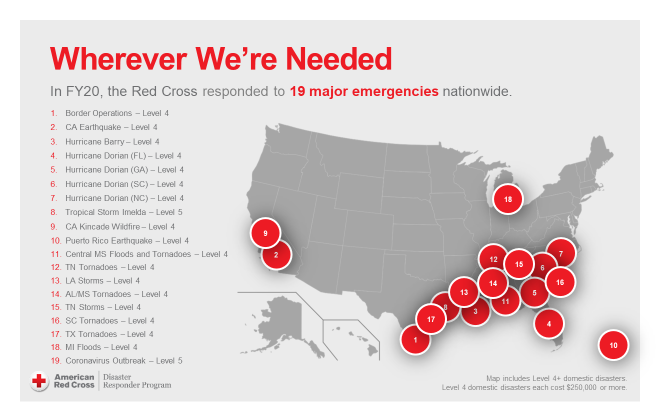
Research shows the climate is changing, and the American Red Cross is witnessing first-hand the adverse impacts of more extreme weather events. In the summer and fall of 2020, Red Cross volunteers - many from Massachusetts - responded to back-to-back disasters including multiple major hurricanes and tropical storms in the south, devastating wildfires in much of the west and the Midwest derecho that caused an estimated $20 billion in damages.
We provide food, shelter and comfort to thousands of people in need; but our volunteers also see the heartbreak of families and communities dealing with the new realities of more intense storms, heavier rainfall, higher temperatures, stronger hurricanes and historic wildfires.
Helping people prepare for, respond to, and recover from disasters has been at the heart of the Red Cross mission since our founding 140 years ago, and the threat of climate change today requires us to adapt and change to meet this challenge.
Here are a few small examples of what we’re doing, together with our partners.
Since 2016, our Operational Readiness Program has focused on planning for, allocating, managing and sustaining our most critical response resources based on our highest probability disaster risks in each community. Planning assumptions include conditions such as sea level rise, more frequent heat extremes and heat waves, drought-caused wildfires, heavy precipitation events and more intense tropical cyclones with higher peak wind speeds and heavier precipitation. Trusted scientific agencies including NASA predict all these effects will continue as the result of climate change.
We are identifying and implementing long-term recovery strategies that combine disaster risk and vulnerability reduction, environmental sustainability, and community survivability—for example, in the aftermath of Hurricane Maria in Puerto Rico, the Red Cross funded the installation of solar micro-grid power systems in schools to help ensure they could serve as emergency shelters with electricity to power lights, kitchens, water pumps and water heaters.
Internationally, we are also expanding support for climate-smart practices throughout the global Red Cross and Red Crescent network. The Red Cross’s Global Disaster Preparedness Center has been actively engaging on climate adaptation activities in countries around the world. With support from USAID, the GDPC has developed tools for use in coastal cities for coalition building, assessment and human centered design/design thinking to prioritize efforts to combat the effects of climate change in urban settings.
Addressing the threat of climate change will require the collective efforts of all of us to build resiliency in our communities and help alleviate human suffering. The Red Cross, through its strong network of volunteers, donors and partners, will do its part to ensure we can meet this challenge and continue to provide help and hope to those in need – not just on Earth Day, but every day moving forward.